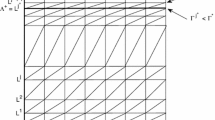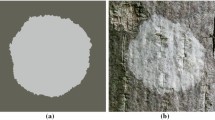Abstract
A tissue is a geometrical, space-filling, random cellular network; it remains in this steady state while individual cells divide. Cell division is a local, elementary topological transformation which establishes statistical equilibrium of the structure. We describe the physical conditions to maintain stationary the epidermis (of mammals or of the cucumber), in spite of the fact that cells constantly divide and die. Specifically, we study the statistical equilibrium of the basal layer, a corrugated surface filled with cells, constituting a two-dimensional topological froth. Cells divide and detach from the basal layer, and these two topological transformations are responsible for the stationary state of the epidermis. The topological froth is capable of responding rapidly and locally to external constraints, and is a good illustration of the plasticity of random cellular networks.
Statistical equilibrium is controlled by entropy, both as a measure of disorder and as information, and is characterized by observable relations between average cell shapes and sizes. The technique can be applied to any random cellular network in dynamical equilibrium. Mitosis as the dominating topological transformation and the fact that the distribution of cell shapes is very narrow are the only inputs specific to biology.
Resume
Un tissu est, à première vue, un pavage aléatoire d'une surface ou d'un volume par des polygones (polyèdres) topologiques, les cellules. Ce pavage reste dans un état stationnaire alors que les cellules se divisent constamment. Nous décrivons les conditions physiques nécessaires à l'état stationnaire de l'épiderme (des mammifères et du concombre), en dépit du fait que ses cellules se divisent et meurent. En particulier, nous étudions l'équilibre statistique de la couche basale, une surface couverte de cellules constituant une mousse topologique aléatoire. Les cellules se divisent et se détachent de la couche basale, et ces transformations topologiques sont responsable de l'état stationnaire de l'épiderme. Cette mousse topologique est capable de répondre rapidement et localement à des contraintes externes. C'est un exemple de plasticité de structures cellulaires aléatoires.
L'équilibre statistique est contrôlé par l'entropie qui est ici à la fois une mesure du désordre et une quantité d'information. Il est caractérisé par des relations facilement observables entre les formes des cellules et leurs dimensions. Les seuls éléments spécifiques aux tissus biologiques sont la mitose comme transformation topologique dominante, et l'étroitesse de la distribution des formes de cellules.
Similar content being viewed by others
References
Aboav, D.A. (1970). The arrangement of grains in a polycrystal. Metallogr. 3: 383.
Aubert, J.H., A.M. Kraynick and P.B. Rand (1986). Aqueous Foams. Scientific American 255: 58.
Barrandon Y and H. Green (1985). Cell size as a determinant of the clone-forming ability of human keratinocytes. Proc. Natl. Acad. Sci. USA, 82.
Berndl, K., J. Käs, R. Lipowsky, E. Sackmann and U. Seifert (1991) Vesicle shapes and shape transformations; A systematic study. In: L. Peliti, ed., Biologically Inspired Physics, p. 95. Plenum.
Blanc M. and A. Mocellin (1979). Grain coordination in plane sections of polycrystals. Acta Metall. 27: 1231.
Bouligand, Y. (1990). Comparative geometry of cytomembranes and water-lipid systems. J. Physique 51: C7–35.
Delannay, R., G. Le Caër and M. Khatun (1992). Random cellular structures generated from a 2D Ising ferromagnet. J. Phys. A 25: 6193.
Delannay, R. and G. Le Caër (1994). Topological characteristics of 2D cellular structures generated by fragmentation. Phys. Rev. Letters 73: 1553.
Delaye, M. and A. Tardieu (1983). Short-range order of crystallin proteins accounts for eye lens transparency. Nature 302: 415.
Dormer, K.J. (1980). Fundamental Tissue Geometry for Biologists. Cambridge Univ. Press.
Dubertret, B. (1994). Etude de l'influence de la mort cellulaire sur l'équilibre statistique de l'épiderme des mammifères. Thesis, ULP, Strasbourg.
Errera, L. (1886). Sur une condition fondamentale d'équilibre des cellules vivantes. Comptes Rendus Acad. Sci. 103: 822.
Flyvbjerg, H. (1993). Model for coarsening froths and foams. Phys. Rev. E 47: 4037.
Godrèche, C., I. Kostov and I. Yekutieli (1992). Topological correlations in cellular structures and planar graphy theory. Phys. Rev. Letters 69: 2674.
Hales, S. (1727). Vegetable Staticks. Innis and Woodward.
Le Caër, G. and R. Delannay (1993). Correlations in topological models of 2D random cellular structures. J. Phys. A 26: 3931.
Le Caër, G. and R. Delannay (1995). Topological models of 2D fractal cellular structures. J. Phys I (Paris).
Lemaître, J., A. Gervois, J.-P. Troadec, N. Rivier, M. Ammi, L. Oger and D. Bideau (1993). Arrangements of cells in Voronoi tessellations of monosize packings of discs. Phil. Mag. B 67: 347.
Lemaître, J., J.-P. Troadec, A. Gervois and D. Bideau (1991). Experimental study of densification of disk assemblies. Europhys. Lett. 14: 77.
Lewis, F.T. (1928). The correlation between cell division and the shapes and sizes of prismatic cells in the epidermis ofcucumis. Anat. Records 38: 341.
Lewis, F.T. (1930). A volumetric study of the growth and cell division in two types of epithelium, the longitudinally prismatic epidermal cells oftradescantia and the radially prismatic epidermal cells ofcucumis. Anat, Records 47: 59.
Lewis, F.T. (1931). A comparison between the mosaic of polygons in a film of artificial emulsion and the pattern of simple epithelium in surface view (cucumber epidermis and human amnion). Anat. Records 50: 235.
Lipowsky, R. (1990). Critical behavior of vesicles and membranes. J. Physique 51: C7–243.
Matzke, E.B. (1950). In the twinkling of an cye. Bull. Torrey Bot. Club 27: 222.
Mombach, J.C.M., M.A.Z. Vasconcellos, R.M.C. de Almeida (1990). Arrangement of cells in vegetable tissues. J. Phys. D. 23: 600.
Montagna W. and P.F. Parakkal (1974) In: The Structure and Function of Skin. Academic Press (3rd edition), Chap. 2.
Peshkin, M.A., K.J. Strandburg and N. Rivier (1991). Entropic predictions for cellular networks. Phys. Rev. Letters 67: 1803.
Pyshnov, M.B. (1980). Topological solution for cell proliferation in intestinal crypt. I-Elastic growth without cell loss. J. Theor. Biol. 87: 189.
Rivier, N. (1988). Statistical geometry of tissues. In: I. Lamprecht and A.I. Zotin, eds., Thermodynamics and Pattern Formation in Biology, p. 415. de Gruyter.
Rivier, N. (1993). Order and disorder in packings and froths. In: D. Bideau and A. Hansen, eds., Disorder and Granular Media, p. 55. North Holland.
Rivier, N. (1994). Maximum entropy for random cellular structures. In: P. Grassberger and J.-P. Nadal, eds., From Statistical Mechanics to Statistical Inference and back, p. 77. Kluwer.
Rivier, N., X. Arcenegui-Siemens and G. Schliecker (1995). Cell division and evolution of biological tissues. In: D. Beysens, X. Campi and E. Perfferkorn, eds., Fragmentation Physics, p. 266. World Scientific.
Rivier N. and B. Dubertret (1995). Why does skin stay smooth?. Phil. Mag. B 72: 311.
Rivier N. and A. Lissowski (1982). On the correlation between sizes and shapes of cells in epithelial mosaics. J. Phys. A 15: L143.
Smoljaninov V.V. (1980). Mathematical Models of Tissues. Nauka (in Russian).
Stavans, J., E. Domany and D. Mukamel (1991). Universality and pattern selection in two-dimensional cellular structures. Europhys. Letters 15: 479.
Telley, H. (1989). Modélisation et Simulation de la Croissance des Mosaiques Polycristallines. Thesis, EPFL, Lausanne.
Telley, H., Th.M. Liebling and A. Mocellin (1995). The Laguerre model of grain growth in two dimensions. I: Cellular structures viewed as dynamical Laguerre tessellations. II: Examples of coarsening simulations. Phil. Mag. to appear.
Thompson, D'A.W. (1942). On Growth and Form. Cambridge Univ. Press (2nd. ed.), p. 363, 482.
Weaire D. and N. Rivier (1984). Soap, cells and statistics-Random patterns in two dimensions. Contemp. Phys. 25: 59.
Author information
Authors and Affiliations
Rights and permissions
About this article
Cite this article
Rivier, N., Schliecker, G. & Dubertret, B. The stationary state of epithelia. Acta Biotheor 43, 403–423 (1995). https://doi.org/10.1007/BF00713562
Issue Date:
DOI: https://doi.org/10.1007/BF00713562




